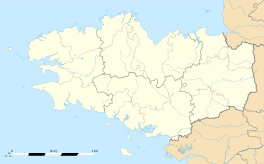Lamballe
| Lamballe Lambal | ||
|---|---|---|
 | ||
| ||
 Lamballe | ||
|
Location within Brittany region  Lamballe | ||
| Coordinates: 48°28′10″N 2°31′00″W / 48.4694°N 2.5167°WCoordinates: 48°28′10″N 2°31′00″W / 48.4694°N 2.5167°W | ||
| Country | France | |
| Region | Brittany | |
| Department | Côtes-d'Armor | |
| Arrondissement | Saint-Brieuc | |
| Canton | Lamballe | |
| Intercommunality | Lamballe Communauté | |
| Government | ||
| • Mayor (2014–2020) | Loïc Cauret | |
| Area1 | 90.21 km2 (34.83 sq mi) | |
| Population (2013)2 | 13,804 | |
| • Density | 150/km2 (400/sq mi) | |
| Time zone | CET (UTC+1) | |
| • Summer (DST) | CEST (UTC+2) | |
| INSEE/Postal code | 22093 / 22400 | |
| Elevation | 37–131 m (121–430 ft) | |
|
1 French Land Register data, which excludes lakes, ponds, glaciers > 1 km² (0.386 sq mi or 247 acres) and river estuaries. 2 Population without double counting: residents of multiple communes (e.g., students and military personnel) only counted once. | ||
Lamballe (Breton: Lambal, Gallo: Lanball) is a commune in the Côtes-d'Armor department in Brittany in northwestern France.
It lies on the Gouessant 13 miles (21 km) east-southeast of Saint-Brieuc by rail.
History
Lamballe was the capital of the territory of the Counts of Penthièvre, who in 1569 were made dukes. La Noue, the famous Huguenot leader, was mortally wounded in 1591 in the siege of the castle, which was dismantled in 1626 by Richelieu. The last Duke of Penthièvre granted his son Louis the title Prince of Lamballe. The Prince de Lamballe married Marie Therese de Savoie-Carignan and she took the title Princesse de Lamballe. The Princesse lived with her father-in-law after the early death of her husband. She was a close friend of Queen Marie Antoinette and one of the most famous victims of the French Revolution.
Charles Armand Tuffin, marquis de la Rouerie, hero of the American war of independence, died near Lamballe in 1793. Chilean dictator Augusto Pinochet's father was a Lamballe native of Breton descent.
On 1 January 2016 the former commune of Meslin was merged into Lamballe.[1]
Population
| Historical population | ||
|---|---|---|
| Year | Pop. | ±% |
| 1793 | 3,907 | — |
| 1800 | 4,402 | +12.7% |
| 1806 | 3,873 | −12.0% |
| 1821 | 4,253 | +9.8% |
| 1831 | 4,390 | +3.2% |
| 1836 | 4,396 | +0.1% |
| 1841 | 4,206 | −4.3% |
| 1846 | 4,212 | +0.1% |
| 1851 | 4,187 | −0.6% |
| 1856 | 4,092 | −2.3% |
| 1861 | 4,256 | +4.0% |
| 1866 | 4,151 | −2.5% |
| 1872 | 4,295 | +3.5% |
| 1876 | 4,255 | −0.9% |
| 1881 | 4,515 | +6.1% |
| 1886 | 4,429 | −1.9% |
| 1891 | 4,529 | +2.3% |
| 1896 | 4,531 | +0.0% |
| 1901 | 4,391 | −3.1% |
| 1906 | 4,562 | +3.9% |
| 1911 | 4,528 | −0.7% |
| 1921 | 4,460 | −1.5% |
| 1926 | 4,708 | +5.6% |
| 1931 | 4,775 | +1.4% |
| 1936 | 5,048 | +5.7% |
| 1946 | 5,646 | +11.8% |
| 1954 | 5,641 | −0.1% |
| 1962 | 5,069 | −10.1% |
| 1968 | 5,075 | +0.1% |
| 1975 | 9,330 | +83.8% |
| 1982 | 9,452 | +1.3% |
| 1990 | 9,894 | +4.7% |
| 1999 | 10,563 | +6.8% |
| 2008 | 11,705 | +10.8% |
Inhabitants of Lamballe are called lamballais in French.
Sights
Crowning the eminence on which the town is built is a beautiful Gothic church (13th and 14th centuries), once the chapel of the castle of the counts of Penthièvre.
Of the other buildings, the church of St Martin (11th, 16th and 16th centuries) is the chief.
Economy
Lamballe has an important haras (depôt for stallions) and carries on trade in grain, tanning and leather-dressing; earthenware is manufactured in the environs.
The town of Lamballe is noted for its exceptional weekly market. Although held on Thursday mornings only, this market is known as one of France's finest, with people travelling from far and wide to visit it and to enjoy its gastronomic delights. According to locals, something that must be tried here is a local speciality of gallettes with sausages, apparently irresistibly delicious, and also the Breton buckwheat pancakes (Gallettes, the sweet ones are the crepes that we are all familiar with), cider and seafood for which the area is famed.
International relations
Lamballe is twinned with Oliveira do Bairro, Portugal
See also
- Communes of the Côtes-d'Armor department
- Élie Le Goff Sculptor of Lamballe war memorial
References
- ↑ Arrêté préfectoral 9 December 2015 (French)
-
 This article incorporates text from a publication now in the public domain: Chisholm, Hugh, ed. (1911). "article name needed". Encyclopædia Britannica (11th ed.). Cambridge University Press.
This article incorporates text from a publication now in the public domain: Chisholm, Hugh, ed. (1911). "article name needed". Encyclopædia Britannica (11th ed.). Cambridge University Press.
External links
| Wikimedia Commons has media related to Lamballe. |
- Official website (French)
- French Ministry of Culture list for Lamballe (French)
- http://www.cm-olb.pt/PageGen.aspx?WMCM_PaginaId=29015
.svg.png)